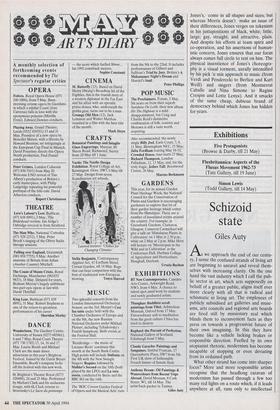Exhibitions
Five Protagonists (Browse & Darby, till 21 May) Fluxbritannica: Aspects of the Fluxus Movement 1962-73 (Tate Gallery, till 19 June) Simon Lewis (Todd Gallery, till 14 May)
Schizoid state
Giles Auty
Awe approach the end of our centu- ry, I sense the confused strands of living art are beginning to unravel and reveal them- selves with increasing clarity. On the one hand the vast industry which I call the pub- lic sector in art, which acts supposedly on behalf of a greater public, aligns itself ever more clearly with all that is radical and schismatic in living art. The employees of publicly subsidised art galleries and muse- ums, arts councils and regional arts boards are fired still by missionary zeal which blinds them to inconvenient facts as they press on towards a progressivist future of their own imagining. In this they have become like a vehicle lacking brakes or responsible direction. Fuelled by its own utopianist rhetoric, modernism has become incapable of stopping or even deviating from its ordained path.
What other strand has come into sharper focus? More and more responsible artists recognise that the headlong caravan of modernism has passed through a few too many red lights on a route which, if it leads anywhere at all, runs only to intellectual desert. Accordingly they have looked afresh at the advantages of continuity rather than continuous revolution and are busy re-negotiating personal pacts with art's historic past. Simply through the act of painting many re-affirm their faith in the efficacy of a medium which has been certi- fied as dead for approaching 30 years — if only by those who will not or cannot grasp its potential.
At Browse & Darby (19 Cork Street, W1) an intelligent exhibition examines in detail the divergent roads taken by five British artists who have shown long-term dedication to painting. Typically the exhibi- tion takes place at a private commercial gallery. We may not hope to see shows dis- tinguished by such relevance or appeal in public sector outlets for the reasons out- lined already. While the Tate pays nostalgic tribute, largely by documentation, to the rabid radicalism of the short-lived Fluxus movement, 1962-73, its controllers largely disregard living art which tries to introduce sense or continuity back into the blood- stream. The five painters on view now at Browse & Darby were all in their late thir- ties in 1962. Why did they too not trip over themselves to join a merry-go-round whose horses were ridden by such eminently for- gettable folk as Yoko Ono, Genesis P- Orridge, Cosey Fanni Tutti and Stuart Brisley? Sandy Nairne who, by strange coincidence, occupies an extremely influen- tial post now at the Tate, was yet another who participated in the Fluxus movement. What was Fluxus? The Tate's own publicity says it all: `By combining elements of Futurist theatre and Dadaist irrationality with the philosophy of Marcel Duchamp and the Zen-based teachings of John Cage, Fluxus created work that was ephemeral, interactive and humorous.' Only the last claim is disputed.
The five protagonists at Browse & Darby are Craigie Aitchison, Anthony Eyton, Patrick George, Myles Murphy and Euan Uglow. All were taught by the late William Coldstream who at that time believed still in the possibility of depicting the real. Like most artists taught initially on courses which included a measure of structure and rigour, the five have subsequently devel- oped highly individual artistic personalities. My personal preferences are for Uglow and Eyton who have become especially well- rounded artists but the remainder do not lack admirers. A measured catalogue essay by Andrew Lambirth contrasts favourably with the broadsheet which eulogises the supposed wonders of Fluxus at the Tate Gallery. Why are the scales tilted so heavily by officers of the pubilic sector in favour of radicalism rather than tradition and conti- 'Indian Courtyard' 1994, oil on board, by Anthony Eyton nuity? We need look no further here than a self-perpetuating modernist hegemony which controls careers and professional opportunity of all kinds. Such dominance must be by-passed or broken up before art can breathe freely again or develop in directions of its own rather than our art administrators' choosing.
What effect does this public sector bias have on young artists? A young man enjoy- ing his first solo show at the attractive Todd Gallery (1-5 Needham Road, W11) illustrates the schizoid state of living art almost to perfection. Simon Lewis has pro- duced a series of exquisite miniature English landscapes painted with all the detail and dedication of a quattrocentro specialist. But, having made them quite beautifully, he finds it necessary to explain them away verbally in case someone from an influential public-sector organisation might be looking.
It would be death to appear reactionary in the eyes of such folk however much he may have enjoyed making his remarkable little images. As insurance against the for- mer, the artist is also showing minimalist geometrical grids built up via layers of trac- ing paper. According to the artist, the link between these two utterly divergent modes is space but some might diagnose state- induced schizophrenia.



























































 Previous page
Previous page